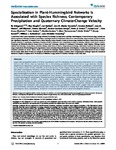Specialization in Plant-Hummingbird Networks Is Associated with Species Richness, Contemporary Precipitation and Quaternary Climate-Change Velocity
| dc.contributor.author | Dalsgaard, B | |
| dc.contributor.author | Magård, E | |
| dc.contributor.author | Fjeldså, J | |
| dc.contributor.author | Martín González, AM | |
| dc.contributor.author | Rahbek, C | |
| dc.contributor.author | Olesen, JM | |
| dc.contributor.author | Ollerton, J | |
| dc.contributor.author | Alarcón, R | |
| dc.contributor.author | Cardoso Araujo, A | |
| dc.contributor.author | Cotton, PA | |
| dc.contributor.author | Lara, C | |
| dc.contributor.author | Machado, CG | |
| dc.contributor.author | Sazima, I | |
| dc.contributor.author | Sazima, M | |
| dc.contributor.author | Timmermann, A | |
| dc.contributor.author | Watts, S | |
| dc.contributor.author | Sandel, B | |
| dc.contributor.author | Sutherland, WJ | |
| dc.contributor.author | Svenning, J-C | |
| dc.date.accessioned | 2018-08-13T10:56:57Z | |
| dc.date.available | 2018-08-13T10:56:57Z | |
| dc.date.issued | 2011 | |
| dc.identifier.issn | 1932-6203 | |
| dc.identifier.issn | 1932-6203 | |
| dc.identifier.other | ARTN e25891 | |
| dc.identifier.uri | http://hdl.handle.net/10026.1/12029 | |
| dc.description.abstract |
Large-scale geographical patterns of biotic specialization and the underlying drivers are poorly understood, but it is widely believed that climate plays an important role in determining specialization. As climate-driven range dynamics should diminish local adaptations and favor generalization, one hypothesis is that contemporary biotic specialization is determined by the degree of past climatic instability, primarily Quaternary climate-change velocity. Other prominent hypotheses predict that either contemporary climate or species richness affect biotic specialization. To gain insight into geographical patterns of contemporary biotic specialization and its drivers, we use network analysis to determine the degree of specialization in plant-hummingbird mutualistic networks sampled at 31 localities, spanning a wide range of climate regimes across the Americas. We found greater biotic specialization at lower latitudes, with latitude explaining 20-22% of the spatial variation in plant-hummingbird specialization. Potential drivers of specialization--contemporary climate, Quaternary climate-change velocity, and species richness--had superior explanatory power, together explaining 53-64% of the variation in specialization. Notably, our data provides empirical evidence for the hypothesized roles of species richness, contemporary precipitation and Quaternary climate-change velocity as key predictors of biotic specialization, whereas contemporary temperature and seasonality seem unimportant in determining specialization. These results suggest that both ecological and evolutionary processes at Quaternary time scales can be important in driving large-scale geographical patterns of contemporary biotic specialization, at least for co-evolved systems such as plant-hummingbird networks. | |
| dc.format.extent | e25891-e25891 | |
| dc.format.medium | Print-Electronic | |
| dc.language | en | |
| dc.language.iso | eng | |
| dc.publisher | Public Library of Science (PLoS) | |
| dc.subject | Animals | |
| dc.subject | Biodiversity | |
| dc.subject | Birds | |
| dc.subject | Climate Change | |
| dc.subject | Geography | |
| dc.subject | Plants | |
| dc.subject | Rain | |
| dc.title | Specialization in Plant-Hummingbird Networks Is Associated with Species Richness, Contemporary Precipitation and Quaternary Climate-Change Velocity | |
| dc.type | journal-article | |
| dc.type | Article | |
| plymouth.author-url | https://www.ncbi.nlm.nih.gov/pubmed/21998716 | |
| plymouth.issue | 10 | |
| plymouth.volume | 6 | |
| plymouth.publication-status | Published online | |
| plymouth.journal | PLoS ONE | |
| dc.identifier.doi | 10.1371/journal.pone.0025891 | |
| plymouth.organisational-group | /Plymouth | |
| plymouth.organisational-group | /Plymouth/Faculty of Science and Engineering | |
| plymouth.organisational-group | /Plymouth/Faculty of Science and Engineering/School of Biological and Marine Sciences | |
| plymouth.organisational-group | /Plymouth/REF 2021 Researchers by UoA | |
| plymouth.organisational-group | /Plymouth/REF 2021 Researchers by UoA/UoA06 Agriculture, Veterinary and Food Science | |
| plymouth.organisational-group | /Plymouth/Research Groups | |
| plymouth.organisational-group | /Plymouth/Research Groups/Marine Institute | |
| plymouth.organisational-group | /Plymouth/Users by role | |
| plymouth.organisational-group | /Plymouth/Users by role/Academics | |
| dc.publisher.place | United States | |
| dcterms.dateAccepted | 2011-09-12 | |
| dc.identifier.eissn | 1932-6203 | |
| dc.rights.embargoperiod | Not known | |
| rioxxterms.versionofrecord | 10.1371/journal.pone.0025891 | |
| rioxxterms.licenseref.uri | http://www.rioxx.net/licenses/all-rights-reserved | |
| rioxxterms.licenseref.startdate | 2011 | |
| rioxxterms.type | Journal Article/Review |


